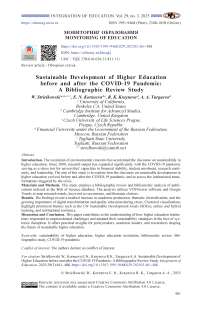Sustainable Development of Higher Education before and after the COVID-19 Pandemic: A Bibliographic Review Study
Автор: Strielkowski W., Korneeva E.N., Krayneva R.K., Turgaeva A.A.
Журнал: Интеграция образования @edumag-mrsu
Рубрика: Мониторинг образования
Статья в выпуске: 3 (120), 2025 года.
Бесплатный доступ
Introduction. The escalation of environmental concerns has accelerated the discourse on sustainability in higher education. Since 2000, research output has expanded significantly, with the COVID-19 pandemic serving as a stress test for universities’ capacities in financial stability, student enrolment, research continuity, and leadership. The aim of this study is to explore how the discourse on sustainable development in higher education evolved before and after the COVID-19 pandemic and to assess the institutional transformations triggered by the crisis. This study employs a bibliographic review and bibliometric analysis of publications indexed in the Web of Science database. The analysis utilizes VOSViewer software and Google Trends to map research trends, keyword co-occurrence, and thematic clusters. Results. The findings reveal a marked increase in academic production, thematic diversification, and the growing importance of digital transformation and quality education during crises. Clustered visualizations highlight prominent themes such as the UN Sustainable Development Goals (SDGs), online and hybrid learning, and institutional resilience. Discussion and Conclusion. This paper contributes to the understanding of how higher education institutions responded to unprecedented challenges and adapted their sustainability strategies in the face of systemic disruption. It offers practical insights for policymakers, academic leaders, and researchers shaping the future of sustainable higher education.
Sustainability of higher education, higher education institution, bibliometric review, bibliographic study, COVID-19 pandemic
Короткий адрес: https://sciup.org/147251787
IDR: 147251787 | УДК: 378:616-036.21:811.111 | DOI: 10.15507/1991-9468.029.202503.461-488
Текст научной статьи Sustainable Development of Higher Education before and after the COVID-19 Pandemic: A Bibliographic Review Study
EDN:
In the past four years, COVID-19 pandemic has brought about some longterm and substantial consequences for the sustainability of economics and education [1–3]. The sudden shift to online learning and remote work has significantly impacted the sustainability of these institutions [4; 5], while also fostering innovation, creativity, and enabling positive institutional changes [6; 7]. Broadly speaking, the pandemic highlighted the critical role of higher education in the society, its importance of the economy and regional development, and the significance of ensuring the sustainability of these institutions for the benefit of all [8–10].
The pandemic presented the HEIs with various challenges, including concerns over financial sustainability [11; 12], problems with the student enrolment, limitations on the research activities, and issues with carbon footprint [13; 14]. The COVID-19 immediate effects that resulted in lockdowns and the disruption of learning process and on-campus activities, led to the significant financial losses for HEIs due to the loss of revenue from student enrolment, housing, and other activities1 [15]. As a result of that, the pandemic also impacted on student enrolment, with many students choosing to defer their studies or pursue other alternatives. Quite often, students had to continue paying their fees (which were quite substantial in the case of some prestigious private universities) even when they were offered on-line learning instead of on-campus teaching and interactions. Some of them started questioning whether this was worth their or their parents’ money [16; 17].
Furthermore, many academic and research activities were affected, as laboratories and research centers were forced to shut down or operate at reduced capacity. Most of the researchers could not travel to research meetings, conferences, and other events which reduced the face-to-face interactions that are often crucial to building personal academic ties and working on collaborative projects [18; 19]. Finally, academic leadership was challenged as well, with many institutions struggling to manage the crisis effectively and responding to the pandemic by reducing their staff or cutting faculty [20; 21].
In response to these challenges, HEIs have implemented various strategies to ensure the sustainability and leadership of their institutions [22]. For instance, many educational and research institutions have implemented strict health and safety protocols, such as social distancing measures, mandatory mask-wearing, and regular sanitization of facilities [23]. As another measure to stop the spread of the coronavirus, they moved to online and hybrid learning models, enabling students to continue their studies remotely (and their faculty to collaborate and research online wherever applicable and feasible) [24; 25]. Furthermore,
HEIs adopted flexible policies to support students, such as deferred enrolment and refunds for housing and other expenses [26]. Additionally, universities and research institutions implemented digital solutions to facilitate research and communication, such as online collaboration tools and virtual conferences [27; 28]. Finally, HEIs fostered a culture of innovation and adaptability, encouraging staff and students to find new ways to address the challenges posed by the pandemic [29]. All the above happened in the matter of weeks or months with the surprising speed and efficiency – implementing the same procedures before the pandemic would have taken years due to the ubiquitous bureaucracy and the administrative barriers [30].
Education systems have been particularly hard hit as mediums of the higher education instruction have been disrupted due to lockdowns and restrictions, meaning learning gaps may widen for those without access to digital resources or adequate support from home [31–33]. These issues are going to persist even after the pandemic passes, making it essential that governments are proactive in addressing existing vulnerabilities so as not to be overwhelmed by the real risk posed by future pandemics or other crises [34; 35].
As the global economy reels from the coronavirus outbreak, governments need to develop sector plans that are robust in promoting entrepreneurship, economic growth and protecting vulnerable populations while also addressing the economic impacts of a broad sector of stakeholders. Similar crises can be used as lessons to assist in preventing future pandemics or other disasters [36–38].
The aim of this study is to systematize and assess academic approaches to the sustainable development of higher education before and after the COVID-19 pandemic through bibliometric analysis, and to identify key transformations in the academic and educational agenda under crisis conditions. Particular attention is given to changes in institutional strategies of universities and the dynamics of scholarly discourse.
Literature Review
Sustainable Development and Higher Education in Academic Literature. In general terms, higher education is described as that having close links to sustainable development and the universities can play a significant role in achieving this [39; 40]. In addition, it plays an important role in strengthening social integration and promoting innovation [41–43]. Therefore, universities should be a part of any strategy to promote sustainable development. The establishment of a global university network could provide a platform for research and knowledge production on sustainability issues, as well as for the exchange of ideas and experiences [44; 45]. In addition, the university network must be attuned to sustainability and the reconciliation of existing projects with long-term objectives. Furthermore, universities should establish rooms where responsible students themselves should study towards sustainable development to turn their agents of change [46]. HEIs also need to create new avenues of engagement for students to be sustainability conscious. This can mean integrating sustainability ideas with current courses or designing new courses that deal with elements of sustainable development, e.g. on climate change or renewable energy [47; 48].
Sustainable development in education is necessary for a better regional economy and human capital according to many scholars. Major structural reforms are thus in place to realign higher education to sustainability [49–51]. To cement this necessary change, it entails a paradigm shift to recognizing sustainability as integral rather than late after the fact across higher education institutions. These involve enhancing supportive higher education institutions and developing and sustaining a sustainable principles-based strategy which should be included within their strategies, structures and delivery of education through ensuring that sustainability is rooted throughout the educational practice [52; 53]. Thence, necessary both the insertion of sustainable practices in the organizational culture and the changes in the development goals of the organization [54]. By armoring young people with appropriate such skills helps him/her to assume leadership in delivering on sustainable development goals defined by the United Nations (UN) [55; 56]. This has profound implications not just for economic growth but also for peace and opportunity across communities [57; 58].
The academic literature shows us that part of the mission of higher educational institutions is to go beyond just providing structured education and, additionally, provide students with tools to comprehend their significance as part of global movements toward sustainable development on a global scale like the UN Sustainable Development Goals (SDGs) [59; 60]. Thus, the HEIs need to create mediums for inculcating realization in students to come up with sustainable solutions catering to local issues keeping in mind the global issues like climate change or poverty alleviation. Moreover, they have an important role to play in helping to create sustainable communities and countries [61; 62]. As key agents for change, universities should focus on providing an environment and resources that enable students to become future leaders with the necessary skills to help meet global sustainable development goals [63–65]. This includes working with stakeholders such as the UN and other international organizations, civil society organizations, business sector, and local communities to build a successful United Nations agenda [66; 67]. Withal, sustainable development in education as higher education is important for improving the regional economy and human capital [68; 69]. Regarding that, many researchers argue that the quality education represents the key to developing a competitive and successful regional economy, promoting research, and creating new knowledge, being innovative and inspiring educational activities, and increasing development capacity building [70–72]. Other studies agree that higher education should also be used to promote economic development by disseminating knowledge, encouraging human resource development, setting high educational standards, supporting universities in their development advancement, providing resources for scientific growth, and creating an environment of learning that encourages creativity [73–75].
Our analysis of the relevant research shows that higher education plays an important role in the region’s economic growth by providing access to quality education that creates skilled professionals who can drive innovation and global competitiveness. Universities are essential for developing technical skills that are needed by companies to remain competitive in the global market [76]. They also provide a platform for research which can lead to cutting-edge discoveries which help promote economic progress and make HEIs more accessible to all people regardless of income or social status [31; 77].
Moreover, from our review of the research literature, it is clear that education programs promote robust human rights that can facilitate sustainable development goals in developing nations [78; 79]. Increasing gender equality in education is a major step toward economic development, poverty alleviation, and health improvements in countries. The human rights argument [80]. The sustainable development goal of (SDG 4) gender equality in education have been endorsed by over 80 countries and is increasingly seen as one of the strongest instruments for promoting [81]. The 2030 Education Programme is a core component of the Global Education Agenda adopted by over 45 countries. This program is designed to intensify the education projects that high-quality investments support and promote shared prosperity to stop extreme poverty (Everything You Need to Know About 2016). It also embraces social change through access to quality education for all. The Aims of UNESCO’s Education for Sustainable Development (ESD) are a natural fit with the World Bank twin goals: End extreme poverty and promote shared prosperity. Setting education to be a torch for economic development and human capital will remain a priority for UNESCO [82]. Meaningful education changes are crucial for meeting the objectives of sustainable development, and ESD can help clarify how those changes happen. In economic development where new insights and insides into education are reported it forms core function for innovative ways of reporting new insights and understanding in education [45; 83]. Some key theories, studies, research or insights encourage critical debate about how education can work for everyone. Quality education is reported to be one medium of economic development such that the return on investment in education could be better than other investments [84; 85]. Some studies found that by supplying quality educational opportunities, greater innovations, knowledge, and skills are fostered which can result in improved human capital with greater returns for economic growth [86; 87]. Furthermore, some researchers argue that improvements in health care also result when quality education is accessible across communities as this facilitates better access to health care services as well as improved knowledge regarding health practices [86; 88]. To facilitate sustainable development in education, it is important to promote technological innovation in education and research. The combination of these elements can then be used to create a platform that universities can use to develop sustainability initiatives [89]. By using SDGs or another regional development model – in the case of a developed area, it can be helped to confirm the collaboration of departmental authorities, fill in the economic gaps and encourage gradual development through partnership [90]. Enhancing the link between the spheres of economic and social development and those of innovation and technology research will allow greater impact in terms of economic growth, fostering partnerships of the whole community [91]. HEIs are also to be leading in this by providing research eligibility for regional sustainable development that incorporates more than just economic growth [92]. For instance, in a developing country, education institutions could leverage their platform to forge partnerships with local businesses and organizations that are interested in creating quality education services while also facilitating initiatives for sustainable economic growth [93]. In addition, universities can partner with other organizations which have similar interests in enhancing their human capital development and the sustainability of their environmental practices [94]. This will help align their efforts toward the regional sustainable development goals to achieve greater impact.
It is worth noting that the COVID-19 pandemic has brought disruption to all areas of our economy and society as well, including the role and place of higher education. Due to the pandemic, these institutions had to adapt to remote learning and remote work, which caused massive disruption in education delivery and research activities [95]. Sustainability and leadership of higher education institutions have been influenced by the pandemic, as many institutions now grapple with financial pressures and strive to preserve enrolment and retain research [96]. Based on earlier research papers and reports from a number of countries, the review focuses on how the pandemic threatens the sustainability of higher education institutions. It shows that the sustainability in higher education is in relation to the coordinate development of several aspects which include environment, economics, culture, gender equality, and responsibility of the community, etc. Hence, the COVID-19 pandemic has significantly challenged the sustainability of HEI [97]. The pandemic led to the normal operation of HEIs being disrupted, with campus closure and suspension of academic activities. This brought direct implications on the finances of HEIs including revenue losses, budget cuts, and increased levels of debt (of HEIs) [98]. The suspension of academic activities, as well as the dwindling enrolment rates, have become the archetype for the financial dilemma of HEIs (Higher Education Institutions). These financial challenges endanger the sustainability of HEIs, which face challenges in terms of maintaining their long-term balance between the dimensions of sustainability [99]. To ensure sustainability, HEIs have needed to face the consequences of the COVID-19 pandemic and act accordingly to be able to lead effectively. There have been several proposals available to facilitate SEI to cope with the new reality. One approach is the use of digital technologies to support remote learning and communication. The closure of campuses has meant that HEIs have had to invest in digital technologies to ensure that academic activities can continue [100]. Diversification of income is another strategy. This has forced HEIs to navigate uncharted territory in terms of revenue diversification, with many exploring partnerships with industry, philanthropic gifts, and fundraising campaigns, in light of the revenue contraction [101].
Thence, one of the major effects of the COVID-19 pandemic on colleges and universities is undoubtedly the financial burden of suddenly moving to remote learning (and remote work). These investments have resulted in higher costs for many institutions [102; 103].
In addition to that, education institutions experienced revenue losses from decreased student enrolment and diminished research activities [104]. Higher education institutions globally experienced a drop in revenue of 10–15% due the COVID-19 Pandemic2. Many institutions have had financial difficulties, with a few even confronting the prospect of shutting down.
Student enrolment in higher education institutions has also been massively impacted by the COVID-19 pandemic. Many students have deferred enrolment or dropped out – for financial reasons, health concerns or challenges with online learning. In a survey conducted by the American Association of Collegiate Registrars and Admissions Officers, 25% of colleges and universities in the United States noted a decrease in undergraduate enrolment in the fall of 2020 [105]. The drop in enrolment has threatened institutions’ fiscal health and could have long-lasting impacts on their governance and competitiveness.
The COVID-19 pandemic has forced HEIs to halt or postpone research activities as limitations on travel and access to laboratories and research facilities restrict access to a working environment. Research has shifted toward COVID-19 and related fields as many institutions and universities have sought to redirect their research and resources to COVID-19. The suspension of research activities has challenged institutions’ sustainability, with some facing the possibility of funding and prestige loss due to a decrease in research productivity [106; 107].
Driven by the new challenges hampered by the pandemic, HEIs were forced to bypass them to overcome the “red tape” as well as their administrative barriers and to come up with effective strategies to address these challenges. Many higher education institutions have turned to one tactic: technology to enable remote learning. These have received significant use from video conferencing applications such as Zoom or Microsoft Teams to online academic education programs like Blackboard or
Canvas. Moreover, institutions also take actions to prepare students for remote learning by ensuring their access to the necessary technological equipment and Internet [108] and another common strategy has included rethinking conventional academic programs and curriculum. HEIs needed to respond swiftly to novel demands and expectations of students during pandemic times, and many of the new courses and programs, which include subjects such as public health, epidemiology and disaster management and response [109]. As a result, there has also been a push towards more flexible and modular learning options, such as micro-credentials and digital badges, that can be earned online and on a more flexible schedule.
All these changes brought about the rise of academic publications that tackled not only sustainable development and higher education but also the impact of the COVID-19 pandemic on them and analyzed the positive and negative effects that emerged. Therefore, there is a clear need to study and analyze these publications and assess their impact and contribution.
Materials and Methods
Outline of Bibliometric Analysis. For the purposes of this review, bibliometric analysis was employed. Figure 1 that follows outlines the main steps of the bibliometric data collection and analysis. It outlines how we proceeded from the definition of the research phenomenon towards the choice of the research publications database and criteria definition and further towards data extraction and analysis. The research outline is similar to the one applied in the study by W. Strielkowski et al. [110] but differs from it in many aspects and provides a wider range and scope.
This bibliometric review might seem to pursue a similar topic as some relevant recent reviews published within the last years. However, unlike M.B. Tafese and E. Kopp [111] who focused on the publications indexed in Scopus database, this study adds distinct value through the deliberate choice of utilizing data from the Web of Science (Web of Science) database that is older (established as Science Citation Index in 1964 while Scopus was launched in 2004), considered highly prestigious, especially within institutions from the USA, Canada, UK, and major Western European countries, preferred in fields prioritizing journal prestige, impact factors, and strict quality criteria (e.g., life sciences, engineering, natural sciences), and more frequently used by institutions concerned with rankings, accreditation, and high-impact research output.
Online Frequency Dynamics. It needs to be stressed that in recent years, higher education, sustainable development, and COVID-19 pandemic became the widely searched terms that often intertwined together from 2020 onwards. Furthermore, Figure 2 below depicts the results of the analytical scanning based on the Google Trends toolkit3 (which is recently popular with researchers analyzing online word searches) showing the frequency dynamics of the worldwide search requests (simultaneous search for the group of items) for such terms as “higher education” and “sustainable development” from 2004 (the first year when the Google search data is available) until today. Figure 2 features the “Interest over Time” (IoT) metrics which assesses the search interest relative to the highest point on the chart for the given region and time (with 100 being the peak popularity and 0 showing that no data was available for the given region and time period). Looking at Figure 2, one can clearly observe that the interest and focus on the term “sustainable development” became entangled with that of “sustainable education” by 2021 measured according to the Interest over Time metrics.
Furthermore, Figure 2 that follows provides an account of the most prolific institutions producing publications on higher education and sustainable development between 1991 and 2023.
By contrast, Figure 3 that is shown below reports the results of the analytical scanning based on the Google Trends4 toolkit showing the frequency dynamics of the search requests for the terms “higher education”, “COVID-19 pandemic”, and “sustainable development” all around the world for the past 3 years starting from
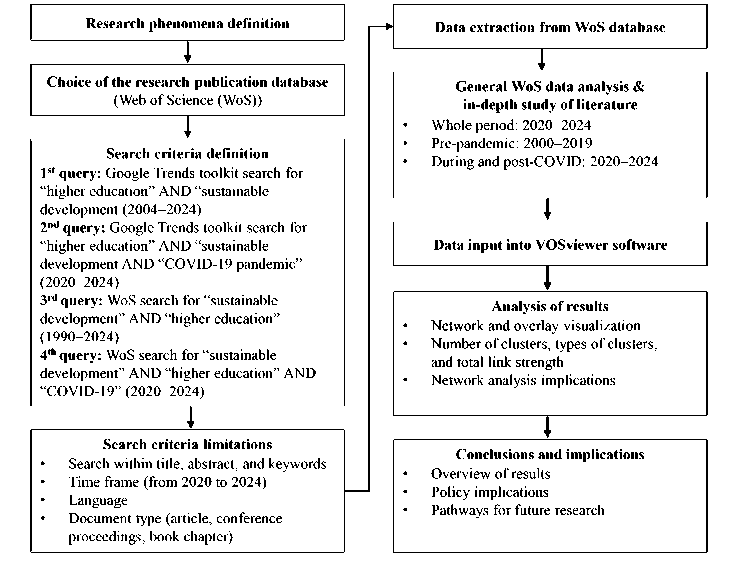
F i g. 1. Overview of the methodology: data collection and analysis
Source : Compiled by the authors.
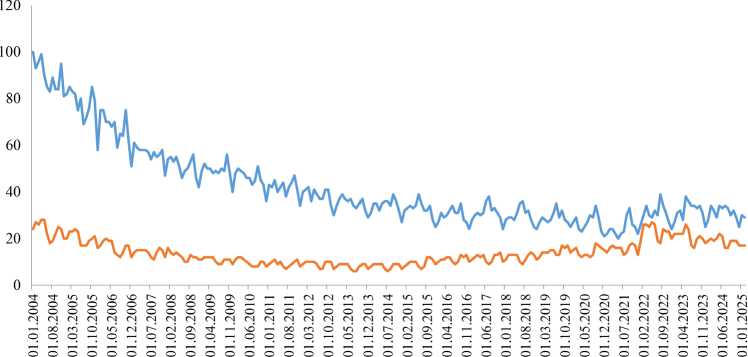
Time
Higher education — Sustainable development
F i g. 2. The worldwide dynamics of frequency of search requests of the concepts of “higher education” and “sustainable development” (2004–2025)
Source : Figures 2, 3 compiled by the authors based on data from a Google Trends.
March 12, 2020 when the World Health Organization (WHO) announced COVID-19 to be a global pandemic, the first one of its kind in the 21st century.
The Data. Our bibliometric analysis used in this study provides a comprehensive review of the challenges and strategies adopted by HEIs in response to the coronavirus crisis. Drawing on research papers published between 2020 and 2023 and indexed in the Web of Science (Web of Science) database, we analyze the impacts of the pandemic on the sustainability and leadership of HEIs, focusing on the
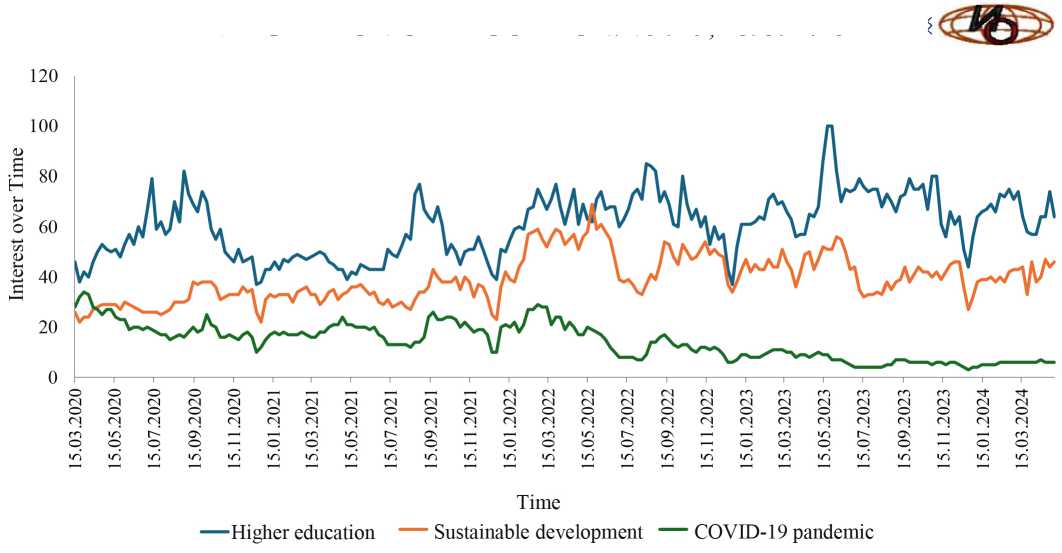
F i g. 3. The worldwide dynamics of frequency of search requests of the concepts of “higher education”, “COVID-19 pandemic”, and “sustainable development” (2020–2024)
challenges faced by institutions in terms of financial sustainability, student enrolment, research activities, and academic leadership. We identify various strategies implemented by HEIs to address these challenges and emphasize the importance of adaptability, resilience, and innovation in their approach to leadership and sustainability. Our review highlights the need for HEIs to develop robust plans for future crises, as well as to foster a culture of innovation and adaptability.
The limitations of this review are obvious. Our choice of papers indexed in Web of Science leaves the papers published in the journals that stand outside (but are otherwise indexed in other prestigious abstract and citation databases such as Scopus). Similarly, it does not cover all publications on the subject that can be found in Google Scholar database. Nevertheless, we think that our results and analysis might be useful for shedding more light on the challenges the higher education institutions regarding sustainability and leadership because of the adverse effects of the COVID-19 pandemic.
Results
Research Context and Periods of Study. In order to conduct a bibliometric analysis of the implications for sustainable development at HEIs during and after the COVID-19 pandemic, we have carried out a structured search within the Web of Science database using the concurrent terms “higher education” and “sustainable development” and identified 8,029 documents (articles, proceedings, book chapters and others (e.g. editorial material)) in total published from 1990 until 2024 (of them 4,080 were published between 2000 and 2019 and 3,887 published between 2020 and 2024).
We start from the performance analysis that yields the annual numbers of publications, as well as the most prolific institutions and academic journals (the period of 1990–1999 is not covered in our analysis due to the marginal number of publications). Then, we move to the assessment of the research evolution and dynamics that covers both pre-pandemic period (2000–2019) as well as the pandemic period (2020–2024) comparing them with the results that include the specific focus on COVID-19 pandemic (terms such as “COVID-19” or “COVID pandemic”). Our results identify the dominant trends, interconnectedness, and network visualization in the intersectoral research in both periods in question. We employ the VOSViewer software which represents a popular tool for the network analysis frequently used for identifying the dominant trends in intersectoral research related to various topics, as well as for finding out which tools and instruments in various fields that are relevant for academics and scholars [112–114].
Performance Analysis . Figure 4 reveals the number of publications on higher education and sustainable development indexed in Web of Science each year from 1990 until 2024. One can observe the steep
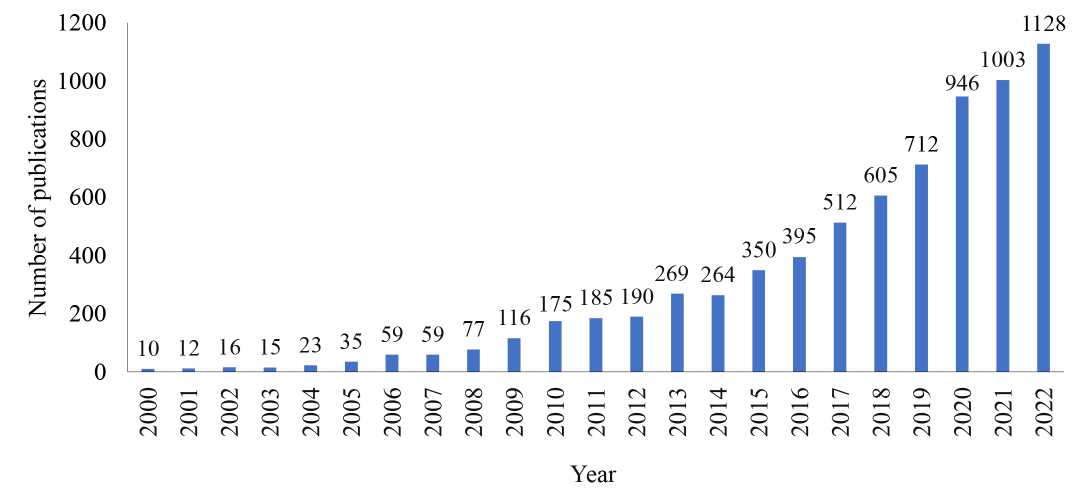
F i g. 4. Annual number of publications on higher education and sustainable development (1990–2024)
Source : Figures 4–6 compiled by the authors based on Web of Science.
rise in the number of publications over the 20 years, from just 1 publication in 1990 to 10 publications in 2000 and then to 1,453 publications in 2024. There was an obvious increase in the number of publications from 2008 to 2009 when it for the first time exceeded the 100-mark reaching 116 publications in total.
Figure 5 provides an account of the most prolific institutions producing publications on higher education and sustainable development between 2000 and 2024. One can see very prestigious institutions such as University of London, University of California, Chinese Academy of Sciences, University of Oxford, or Harvard University being among the top 13 ones.
Furthermore, Figure 6 provides an overview of the most prolific journals publishing articles and proceedings papers on higher education and sustainable development between 2000 and 2024. One can see that the share of the journals by the new publishers is rising compared to the share of the entrenched journals published by the established publishers.
Research Evolution and Dynamics. Pre-Pandemic Period ( 2000–2019 ) . First, we investigate a batch of publication from the pre-pandemic period (2000–2019). Using the specified keywords, a sample of 4,080 documents has been retrieved from Web of Science.
Table 1 offers the typology of empirical research from the point of view of the geographical affiliation of universities. The contribution of higher education to sustainable regional development is differentiated depending on the region, the transmission of values can also be ambiguous.
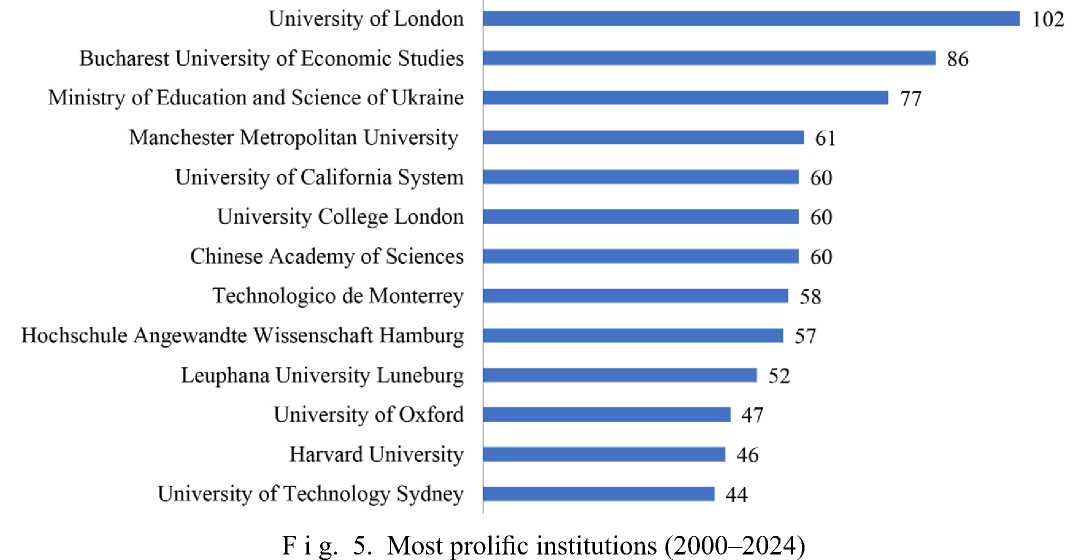
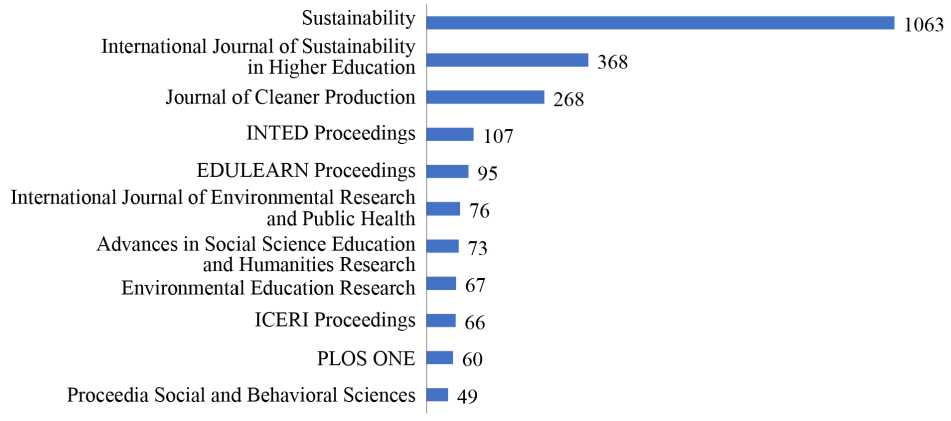
F i g. 6. Most prolific journals (2000–2024)
Thence, this typology can be regionspecific. We have selected the top 5 regions (China, USA, UK, Spain, and Australia) and compared the research areas and links to SDGs (the numbers of brackets show the count of publications).
From Table 1, it becomes obvious that in the pre-pandemic period, the research areas were dominated by Educational Research, Environmental Sciences, and Engineering across all regions. The USA and the UK placed significant emphasis on Science and Technology alongside education and the environment. At the same time, China notably emphasized Social Sciences, Business Economics, and Environmental Sciences. Spain and Australia had fewer publications compared to the USA, China, and the UK, emphasizing educational research and environmental sciences primarily.
When it comes to links to SDGs, there was a universally strong focus on SDG 9 (Industry, Innovation, Infrastructure), SDG 4 (Quality Education), and SDG 13 (Climate Action). China, the USA, and Australia notably included SDG 3 (Good Health and Well-being) in their top areas. Spain uniquely emphasized SDG 12 (Responsible Consumption and Production) and SDG 15 (Life on Land), differentiating its research focus from other countries.
Table 2 that follows lists the top 10 cited articles covering sustainable development and higher education published and indexed in Web of Science between 2000 and 2019.
Furthermore, we analyze the sample of 4,080 documents from Web of Science was conducted using VOSViewer v.1.6.15
software producing a co-occurrence bibliographic data map (Figure 7).
In total, six clusters have been identified from the map depicted in Figure 7. The largest cluster in terms of publications and elements is the red one. It includes terms such as “higher education institutions”, “learning”, or “curriculum”. Some of these studies focus on leadership in higher education [115; 116], or the everyday pro-environmental activities of high school and university students [117]. The second largest cluster is marked in blue color, and it includes terms such as “SDGs”, “access”, or “Africa” indicating the importance of SDGs in both developed and developing regions [122; 123]. The other clusters (the third and the fourth largest marked in olive and red while the others being marginal and small) highlight such terms as “region”, “population”, “poverty”, or “China”, “competitiveness”, or “economic development” [124].
Pandemic Period ( 2020–2024 ) . Table 3 features the typology of empirical research from the point of view of the geographical affiliation of universities, but instead of Table 1 above, it covers the “pandemic” period of 2020–2024 and slightly different top-5 regions (China, Spain, USA, UK, and Germany).
In the “pandemic” period (2020–2024), there has been a shift in the research areas. Significant increase in publications related to Environmental Sciences and Ecology and Science and Technology, notably in China and Spain. Public Environmental Occupational Health became prominent, particularly in the USA and the UK, reflecting pandemic-related concerns.
T a b l e 1. Geographical typology of empirical research (2000–2019)
|
Geographical Affiliation |
Research Areas |
|
China |
Social Sciences (178); Educational Research (168); Business Economics (103); Environmental Sciences and Ecology (90); Engineering (59). |
|
USA |
Educational Research (129); Environmental Sciences and Ecology (100); Engineering (95); Science and Technology (90); Public Environmental Occupational Health (33). |
|
United |
Educational Research (137); |
|
Kingdom |
Environmental Sciences and Ecology (75); Science and Technology (71); Business Economics (44); Engineering (39). |
|
Spain |
Educational Research (141); Science and Technology (43); Environmental Sciences and Ecology (37); Engineering (30); Business Economics (12). Educational Research (80); Environmental Sciences and |
|
Australia |
Ecology (42); Science and Technology (39); Engineering (21); Business Economics (17). |
SDGs
SDG 9: Industry, Innovation, and Infrastructure (71);
SDG 13: Climate Action (54);
SDG 4: Quality Education (45);
SDG 3: Good Health and Well-Being (38);
SDG 11: Sustainable Cities and Communities (37).
SDG 3: Good Health and Well-Being (145);
SDG 9: Industry, Innovation, and Infrastructure (115);
SDG 4: Quality Education (103);
SDG 13: Climate Action (67);
SDG 2: Zero Hunger (54).
SDG 9: Industry, Innovation, and Infrastructure (117);
SDG 4: Quality Education (81);
SDG 3: Good Health and Well-Being (74);
SDG 13: Climate Action (45);
SDG 11: Sustainable Cities and Communities (35).
SDG 9: Industry, Innovation, and Infrastructure (92);
SDG 4: Quality Education (58);
SDG 12: Responsible Consumption and Production
(30);
SDG 13: Climate Action (29);
SDG 15: Life on Land (25).
SDG 3: Good Health and Well-Being (68);
SDG 4: Quality Education (62);
SDG 9: Industry, Innovation, and Infrastructure (56);
SDG 13: Climate Action (21);
SDG 11: Sustainable Cities and Communities (14).
Source : Tables 1–6 compiled by the authors based on database from Web of Science.
T a b l e 2. Top-10 most cited articles (2000–2019)
Article
Number of citations
Lozano R., Lukman R., Lozano F.J., Huisingh D., Lambrechts W. Declarations for Sustai- 549 nability in Higher Education: Becoming Better Leaders, through Addressing the University System [115]
Lozano R., Ceulemans K., Alonso-Almeida M., Huisingh D., Lozano F.J., Waas T., et al. 424 A Review of Commitment and Implementation of Sustainable Development in Higher Education: Results from a Worldwide Survey [116]
Zsóka Á., Szerényi Z.M., Széchy A., Kocsis T. Greening Due to Environmental Education? 423 Environmental Knowledge, Attitudes, Consumer Behavior and Everyday Pro-Environmental Activities of Hungarian High School and University Students [117]
Tai J., Ajjawi R., Boud D., Dawson P., Panadero E. Developing Evaluative Judgement: 274
Enabling Students to Make Decisions about the Quality of Work [118]
Lozano R., Merrill M.Y., Sammalisto K., Ceulemans K., Lozano F.J. Connecting Com- 263 petences and Pedagogical Approaches for Sustainable Development in Higher Education:
A Literature Review and Framework Proposal [119]
Blok V., Wesselink R., Studynka O., Kemp R. Encouraging Sustainability in the Workplace: 262
A Survey on the Pro-Environmental Behaviour of University Employees [120]
Lambrechts W., Mulà I., Ceulemans K., Molderez I., Gaeremynck V. The Integration of 251 Competences for Sustainable Development in Higher Education: An Analysis of Bachelor Programs in Management [121]
Rosati F., Faria L.G. Addressing the SDGs in Sustainability Reports: The Relationship with 249 Institutional Factors [122]
Trencher G., Yarime M., McCormick K.B., Doll C.N., Kraines S.B. Beyond the Third Mis- 247 sion: Exploring the Emerging University Function of Co-Creation for Sustainability [123]
Wals A.E. Sustainability in Higher Education in the Context of the UN DESD: A Review of 230 Learning and Institutionalization Processes [124]
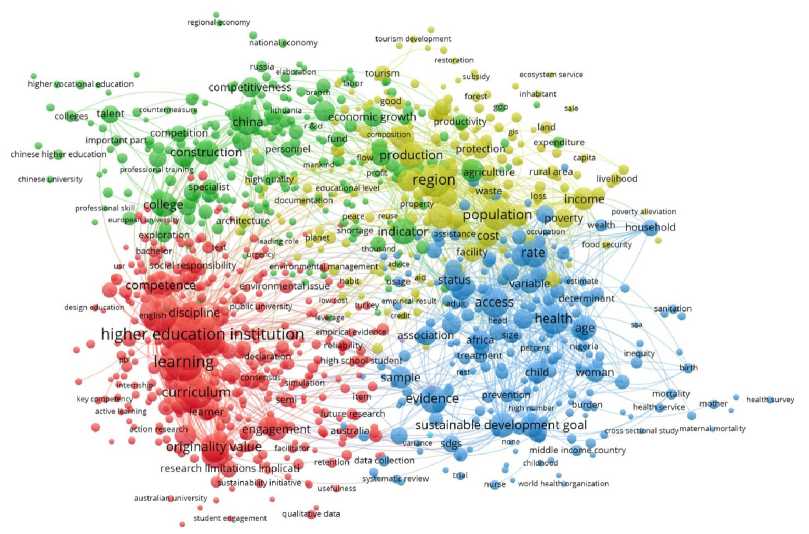
F i g. 7. Co-occurrence map based on the text data of the 4,080 papers containing the keywords “higher education” and “sustainable development” retrieved from Web of Science database
Source : Figures 7, 8, 10, 11 compiled by the author based on VOSViewer v.1.6.15 software.
Educational Research remains significant but relatively less dominant compared to Environmental Sciences and Technology. Computer Science emerges as a distinct area in Spain.
When it comes to the shift in linked SDGs, SDG 9 and SDG 13 notably increase in priority across regions, indicating heightened focus on infrastructure innovation and climate change response. In addition, there has been a significant rise of SDG 12 (Responsible Consumption and Production), especially in China and Spain. Enhanced focus on SDG 3 (Health and Well-being) universally, reflecting health-centric priorities triggered by the pandemic. Emergence of new emphasis areas such as SDG 05 (Gender Equality) in the UK and increased emphasis on SDG 15 (Life on Land) in Germany.
Table 4 lists the top 10 cited articles covering sustainable development and higher education published and indexed in Web of Science between 2020 and 2024.
Even though the number of citations for the publication presented in Table 2 is lower than that from the previous table [125–127] (which is since these publications are quite new and did not collect many citations yet) [128–130], one thing becomes apparent – the topics of sustainable development and higher education become entangled with the topic of COVID-19 pandemic [131; 132].
Figure 8 that follows shows the bibliographic data map based on the text data of the 3,887 papers containing the keywords “higher education” and “sustainable development” created by the VOSViewer software. Like the previous co-occurrence map, there are five main clusters that were identified. The largest cluster is red, and it included terms such as “university”, “student”, or “sustainability”. The second-largest cluster is marked in green color, and it features terms such as “data”, “access”, or “intervention”. SDGs are also featured among the main topics in these and remaining clusters [133; 134]. There also appears the focus that can be derived from the terms appearing on the map on China and India as the largest countries in the world by population and therefore suffering from the pandemic and experiencing its impact on their higher educational systems and their functioning.
<^§^38888888$ ИНТЕГРАЦИЯ ОБРАЗОВАНИЯ. Т. 29, № 3. 2025
T a b l e 3. Geographical typology of empirical research (2020–2024)
|
Geographical Affiliation |
Research Areas |
SDGs |
|
China |
Environmental Sciences and Ecology (479); Science and Technology (413); Educational Research (121); Engineering (108); Public Environmental Occupational Health (52). |
SDG 9: Industry, Innovation, and Infrastructure (301); SDG 13: Climate Action (275); SDG 4: Quality Education (234); SDG 12: Responsible Consumption and Production (186); SDG 3: Good Health and Well-Being (152). |
|
Spain |
Science and Technology (269); Environmental Sciences and Ecology (237); Educational Research (231); Engineering (41); Computer Science (25). |
SDG 9: Industry, Innovation, and Infrastructure (230); SDG 4: Quality Education (178); SDG 13: Climate Action (100); SDG 12: Responsible Consumption and Production (79); SDG 3: Good Health and Well-Being (71). |
|
USA |
Science and Technology (142); Educational Research (138); Environmental Sciences and Ecology (132); Public Environmental Occupational Health (58); Engineering (48). |
SDG 3: Good Health and Well-Being (213); SDG 4: Quality Education (127); SDG 9: Industry, Innovation, and Infrastructure (111); SDG 13: Climate Action (83); SDG 2: Zero Hunger (72) . |
|
United |
Science and Technology (143); |
SDG 3: Good Health and Well-Being (153); |
|
Kingdom |
Educational Research (134); Environmental Sciences and Ecology (113); Public Environmental Occupational Health (55); Business Economics (44). |
SDG 9: Industry, Innovation, and Infrastructure (139); SDG 4: Quality Education (89); SDG 13: Climate Action (72); SDG 05: Gender Equality (58). |
|
Germany |
Science and Technology (169); Environmental Sciences and Ecology (127); Educational Research (112); Engineering (29); Business Economics (13). |
SDG 9: Industry, Innovation, and Infrastructure (134); SDG 13: Climate Action (78); SDG 4: Quality Education (69); SDG 3: Good Health and Well-Being (65); SDG 15: Life on Land (64). |
Pandemic period and “ COVID-19 ” term ( 2020–2024 ). In this sub-section of our study, we additionally apply the bibliometric analysis to the implications for sustainable development at HEIs during and after the COVID-19 pandemic by carrying out a structured search within Web of Science database using both the concurrent terms “higher education” and “sustainable development” (as in the previous cases) as well as “COVID-19”. This selection allowed us to identify 284 indexed documents in total. Table 5 that is shown below provides an overview of the studies related to these topics that were published between 2020 and 2024.
Figure 9 that follows uses the data from the retrieved 284 documen ts to illustrate the most frequent keywords, where a larger size depicts greater frequency within sampled studies.
Furthermore, we conducted a bibliometric network analysis of the sample of papers based on the keywords “higher education”, “COVID-19”, and “sustainable development” in Web of Science.
Table 6 provides an overview of the documents retrieved from Web of Science ordered by their occurrence as well as depicting their relevance (see Table 4 above).
In addition, Figure 10 below shows the results of the network map based on the text data built with the help of VOSView-er v.1.6.15 software.
On the network map presented in Figure 10, we identified and marked 3 main clusters (red, green, and blue). These were the following clusters: 1) Sustainable Development Goals (red clustering); 2) Learning methodology (green clustering), as well as 3) Quality education (blue clustering). Each cluster encapsulated a specific thematic focus, shedding light on the intricate connections between higher education, sustainable development, and the COVID-19 pandemic. The papers in the red cluster focused on
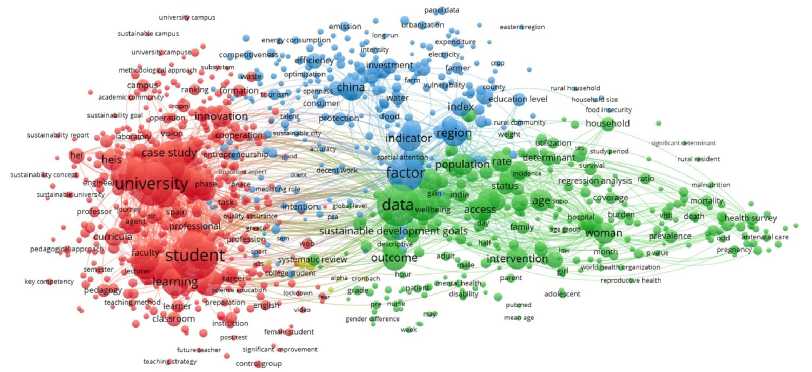
universit* teaching
F i g. 8. Co-occurrence map based on the text data of the 3,887 papers containing the keywords “higher education” and “sustainable development” retrieved from Web of Science database
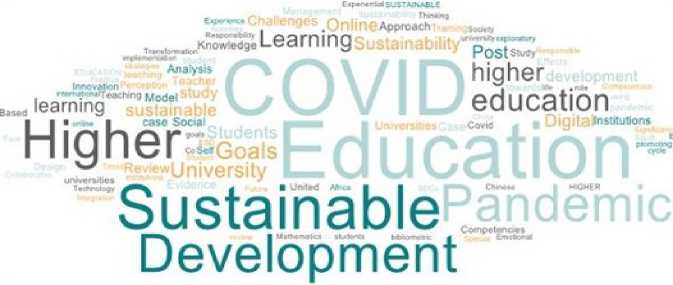
F i g. 9. Word cloud diagram
Source : Compiled by the authors.
higher education institutions contribute to the SDGs, exploring initiatives, policies, and practices geared towards achieving sustainability objectives. This cluster’s emphasis on the SDGs underscores the crucial role higher education plays in addressing global challenges, aligning academic endeavors with broader societal and environmental aspirations. The papers within the green cluster investigated innovative pedagogical approaches, instructional techniques, and digital technologies employed in higher education settings during the pandemic. The green cluster’s prominence suggests a keen interest in understanding how educational institutions adapted to the challenges posed by COVID-19, emphasizing the role of technology-enhanced learning, online platforms, and blended teaching methods. Exploring this cluster further could provide insights into the transformative potential of pedagogical innovations in higher education within the context of sustainability. Finally, the blue cluster encompasses research exploring strategies to maintain and enhance the quality of education, focusing on both academic rigor and student engagement. The research within this cluster focuses on the issues related to curriculum development, assessment methodologies, faculty training, and student support services. The emphasis on quality education within this context highlights the resilience of higher education systems, showcasing efforts to uphold educational standards amid unprecedented challenges.
<^§^38888888$ ИНТЕГРАЦИЯ ОБРАЗОВАНИЯ. Т. 29, № 3. 2025
T a b l e 4. Top-10 most cited articles (2020–2024)
Article
Number of citations
Brundiers K., Barth M., Cebrián G., Cohen M., Diaz L., Doucette-Remington S., et al. Key 162 Competencies in Sustainability in Higher Education – Toward an Agreed-Upon Reference Framework [125]
Sinha A., Sengupta T., Saha T. Technology Policy and Environmental Quality at Crossroads: 81
Designing SDG Policies for Selected Asia Pacific Countries [126]
He K., Chen W., Zhang L. Senior Management’s Academic Experience and Corporate 59 Green Innovation [127]
Crawford J., Cifuentes-Faura J. Sustainability in Higher Education during the COVID-19 57 Pandemic: A Systematic Review [128]
Li M., Yu Z. Teachers’ Satisfaction, Role, and Digital Literacy during the COVID-19 Pan- 43 demic [129]
Filimonau V., Archer D., Bellamy L., Smith N., Wintrip R. The Carbon Footprint of a UK 40 University during the COVID-19 Lockdown [130]
Gómez-Galán J., Martínez-López J.Á., Lázaro-Pérez C., Sarasola Sánchez-Serrano J.L. 37 Social Networks Consumption and Addiction in College Students during the COVID-19
Pandemic: Educational Approach to Responsible Use [131]
Alvarez-Risco A., Del-Aguila-Arcentales S., Rosen M.A., García-Ibarra V., Maycotte-Felkel 32
S., Martínez-Toro G.M. Expectations and Interests of University Students in COVID-19 Times about Sustainable Development Goals: Evidence from Colombia, Ecuador, Mexico, and Peru [132]
Ameli M., Esfandabadi Z.S., Sadeghi S., Ranjbari M., Zanetti M.C. COVID-19 and Sustai- 31 nable Development Goals (SDGs): Scenario Analysis through Fuzzy Cognitive Map Modeling [133]
Leal Filho W., Price E., Wall T., Shiel C., Azeiteiro U.M., Mifsud M., et al. COVID-19: The 31 Impact of a Global Crisis on Sustainable Development Teaching [134]
T a b l e 5. Document sources and characteristics in Web of Science (2020–2024)
|
Year of Publication |
Type of Aocument |
Publisher |
||||||||||
|
2020 |
2021 |
2022 |
2023 |
Article |
Proceedings |
Review |
Editorial |
MDPI |
Elsevier |
Springer |
Frontiers |
Others |
|
23 |
73 |
117 |
71 |
242 |
20 |
19 |
3 |
114 |
27 |
25 |
22 |
77 |
T a b l e 6. Overview of the documents retrieved from Web of Science database.
|
Term |
Occurrence |
Term |
Relevance |
|
SDG |
87 |
Instructor |
4.37 |
|
Country |
79 |
Educator |
3.24 |
|
Learning |
78 |
Child |
3.10 |
|
Teaching |
62 |
Online learning |
2.35 |
|
Technology |
57 |
Online education |
2.10 |
|
Teacher |
49 |
Class |
2.05 |
|
Crisis |
46 |
Originality value |
2.03 |
|
Course |
45 |
Satisfaction |
2.02 |
|
Tool |
41 |
Design methodology |
2.01 |
Furthermore, Figure 11 that follows shows the bibliographic map based on the bibliometric data (co-authorship, keyword co-occurrence, citation, bibliographic coupling, or co-citation map) of the 284 papers containing the keywords “higher education”, “COVID-19”, and “sustainable development” in Web of Science database. One can detect the clear dominant position of COVID-19 (the center of the blue clustering) amidst the terms such as “higher education” or “sustainability” among others.
Our findings that were obtained through the bibliometric network analysis appear to be coherent with similar research that confirmed that higher education and sustainable development during the COVID-19 pandemic were supported by the novel technological approaches to the online learning in many countries (with some countries being more
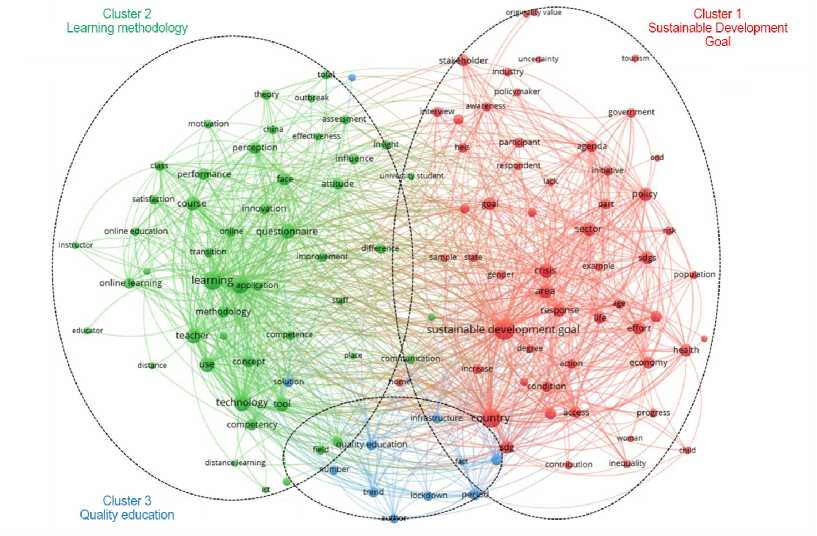
F i g. 10. Co-occurrence network map based on the text data of the 284 papers containing the keywords “higher education”, “sustainable development”, and “COVID-19” retrieved from Web of Science database
innovative and pioneering in implementing them thanks to the approaches of their respective governments, stakeholders, as well as to citizens’ attitudes towards these technologies) which helped to further promote the sustainable development, SDGs, as well as the knowledge of the global warming and the climate change that constitute an important part of the sustainable education agenda.
Discussion and Conclusion
All in all, it is apparent from the recent trends in academic literature that COVID-19 pandemic presented several challenges to the sustainable development of higher education institutions. These institutions became truly synchronous to make this transition possible, which has required tremendous innovation and creativity on their part. The pandemic presented a few challenges for higher education institutions, but it also spurred their innovation and creativity. However, with the use of e-learning systems, these institutions managed to implement e-learning systems and allow students and instructors to conduct learning activities from home. It enabled students, faculty and instructors to examine outcomes, extrapolate views and find the big issues to be addressed. The higher education sector faced some unique challenges that were presented by the pandemic, but it has also had some upsides for public universities. While the traditional education system prevails in several areas, e-learning has provided opportunities for universities that were not previously available. It enables them to reach more students without needing to build the sharp end or staff up. And it allows universities to spot potential trouble spots and intervene before they become real problems. The pandemic created unique challenges for schools of higher education, as institutions were required to quickly pivot their teaching and learning to online modalities. Administrators and faculty had to collaborate to continue providing student services and support in a new context through either distance learning or remote working. Universities were also able to provide faculty with access to the latest technologies, giving them a glimpse into the effects of online teaching and learning. Colleges and universities were compelled to modify their curriculums appropriately to be capable of providing students with a broad variety of educational opportunities across the entire educational scale.
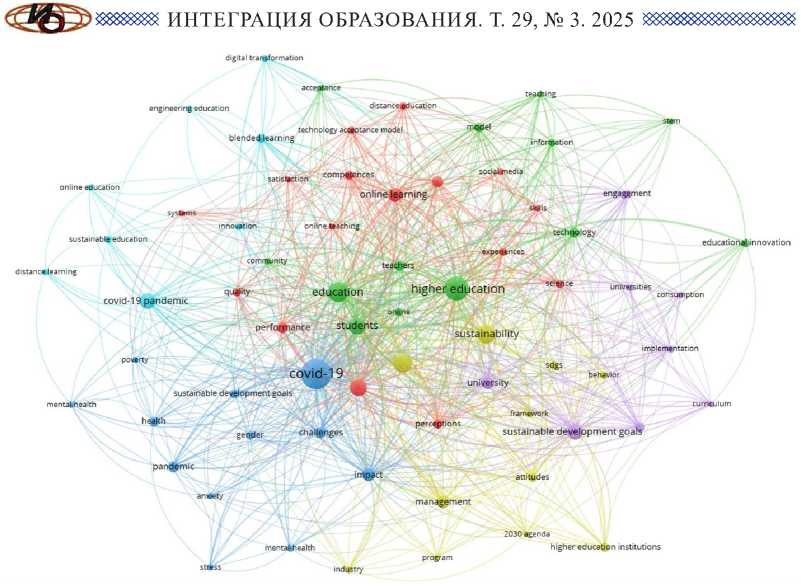
F i g. 11. Bibliographic map based on the bibliometric data (co-authorship, keyword co-occurrence, citation, bibliographic coupling, or co-citation map) of the 284 papers containing the keywords “higher education”, “COVID-19”, and “sustainable development” in Web of Science database
On the positive side, the coronavirus crisis has forced HEI faculty and staff members to be more innovative and find ways to continue to serve our students and customers. The pandemic requires more comprehensive changes and embrace of digital disruption than we have ever seen. This compelled those at HEIs to make a virtue of disruptive innovation and seize on technology adoption to rethink our financial education ecosystems. Leveraging disruptive innovations enabled them to reach disparate student segments and cater to their access to educational resources in ways unimaginable before the crisis.
For many people at HEIs, it took more than a year for to turn from followers into innovators, but these efforts paid off as they are now supporting faculty development efforts, responding quickly as the human situation evolves, and taking on industry-wide initiatives at the tipping point of the pandemic. The commitment should remain strong despite the crisis and the search should continue to find new ways of improving the educational offerings so that HEIs can keep up with rapidly changing times. This is how the pandemic presented challenges for HEIs across the world, but it also boosted their limits in innovation and creativity. These institutions had to quickly adapt to the circumstances whilst being mindful of the health of their students. As our overview of the research literature indicates, HEIs had to reexamine their mandate to provide a quality education at a whole university level, with faculty and students having to force experiment processes, as well as management systems.
When it comes to the typology of empirical research from the point of view of the geographical affiliation of universities, there have also been some changes that occurred due to the pandemic. The pandemic period significantly accelerated the focus on Environmental Sciences and Technology topic. The increased emphasis on Public Environmental Occupational Health demonstrates a reaction to global health challenges. The priority of Good Health and Well-being (SDG 3) escalated notably due to pandemic impacts. The broadened emphasis on responsible consumption (SDG 12) highlights increased global awareness about sustainability and resilience.
The pandemic has also changed the dynamics of the typology of empirical research. Germany replaced Australia in the top 5 regions post-pandemic, possibly due to Germany’s significant scientific investment in health and ecological resilience.
Overall, the results stemming from our comprehensive review and the bibliometric analysis of the relevant research literature reveal that the COVID-19 pandemic had many profound impacts on the sustainability of HEIs worldwide. The pandemic challenged the traditional models of leadership and created significant financial burdens to HEIs, putting their sustainability and often their mere existence at great risk. Effective crisis leadership and adaptation strategies have been critical in ensuring the continuity of academic activities and the sustainability of HEIs. As HEIs adjust to the post-pandemic reality, the adoption of digital technologies and the diversification of revenue streams have been suggested as strategies to help them cope. Clearly, the pandemic was a catalyst for innovation and creativity in how institutions teach, learn, and support their communities. In the face of the continuing pandemic, this is indeed an endorsement from many institutions for higher education to move towards more sustainable injectables for the post pandemic phase.
During the COVID-19 pandemic, these great challenges have turned into solutions of great creativity and innovation in their response by many higher education institutions around the world. One of the biggest innovations was the quick embrace of online learning. HEIs that in the past were reluctant to provide any type of online course or degree rapidly transitioned to remote teaching, very often with stunning success. It opened new possibilities for students who live far from campus or have jobs or family responsibilities that make it hard to be physically present in a classroom.
In addition to that, the COVID-19 has compelled the HEIs to find out new technologies, teaching methods, and ways to improve the overall student experience with online learning. There have been a lot of things that happened during the pandemic, for instance, the universities and institutions that made virtual labs, simulations, and various interactive tools where the students can do hands-on learning activities from a distance. A further example of innovation was the introduction of new strategies for supporting and engaging students. Most of the HEIs introduced online counselling services, virtual meetings and peer-to-peer support networks to keep students connected and engaged in the pandemic. Some other schools, colleges and universities have also adopted a hybrid learning approach where they can offer an online learning facility as well as an offline classroom all at the same time.
Moreover, the coronavirus pandemic underscored the need for research and innovation to tackle global challenges. Universities have been the bedrock of COVID-19 research, responsible for developing vaccines, treatments and testing strategies. It has also emphasized the importance of cross-disciplinary working and the need to connect with communities and stakeholders beyond academia.
Moreover, as far as the empirical research typologies based on geographical affiliations are concerned, it becomes clear that typology became increasingly differentiated post-pandemic, reflecting regional responses to global crises. This confirms the hypothesis of region-specific dynamics in higher education’s contributions to sustainable development. The interdisciplinary integration (environmental sciences, public health, technology) grew, highlighting the need for holistic approaches to sustainable development and resilience. The research in higher education has increasingly aligned with critical global challenges. The SDG framework served effectively as a universal reference for aligning research priorities in response to COVID-19.
Thus, empirical research typologies based on geographical affiliations illustrate not only diversity but also dynamic adaptation to global crises, emphasizing region-specific priorities while responding to global sustainability challenges.
The results of this research demonstrate that challenges in higher education institutions raised from COVID-19 pandemic is phenomenal however, it also turned helpful in utilizing new sources to igniting their innovative and creative sparks in weeks or months. HEIs reacted to this unprecedented crisis with numerous new strategies and approaches to face the challenges resulting from the pandemic. Innovation that created new pathways to students, improved online experience and underscored the role of research and innovation in solving global problems. As higher education institutions continue to navigate the pandemic, they can draw on the lessons learned from these innovations to build a more sustainable and resilient future.
Overall, it becomes clear that structural reform in basic education is needed to ensure students are ready for the skills needed for achieving sustainable development. A quality education for all leads to social, economic, and environmental transformation thus HEIs is the focal point for the implementation of the UN SDGs.
In terms of the pathways for future research, as we explore a shifting landscape of global challenges, a new avenue for future research comes to light. Future researchers may simply want to ask whether academic dialogues about the sustainable development of higher education are still dismantling the transformative consequences brought on by the COVID-19 pandemic. Particularly, scholars could explore whether themes such as the digital surge in academia, the abrupt removal of administrative obstacles through streamlined processes, and the widespread adoption of hybrid or online learning models remain pertinent topics in academic literature. Analyzing the persistence or evolution of these themes would offer valuable insights into the longterm consequences of the pandemic on higher education systems globally. Such research could shed light on the enduring changes in educational methodologies and administrative practices, providing a nuan-ced understanding of the post-pandemic educational landscape. By focusing on these aspects, researchers can significantly contribute to the ongoing discourse on sustainable development in higher education, thereby guiding future policies and practices in the field.

